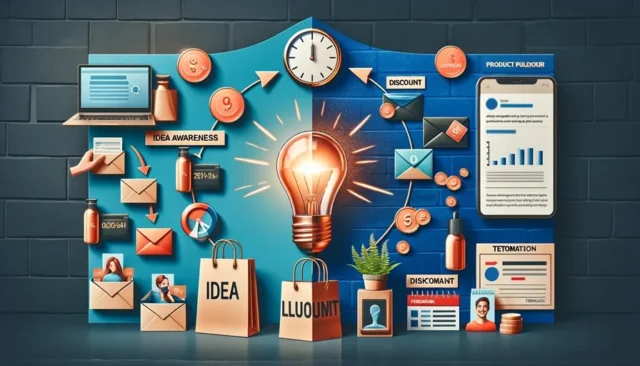Launching a new product is an exciting time for any business, but it also comes with challenges. You want to create buzz, generate interest, and ultimately drive sales—all while ensuring your messaging reaches the right audience. Email marketing is a powerful tool that can help you achieve these goals effectively. In this blog post, we’ll explore how to leverage email marketing for successful product launches, providing you with actionable strategies to make your launch a resounding success.

Table of Contents
Toggle1. Build Anticipation with a Teaser Campaign
Before the official launch, generate excitement and curiosity about your upcoming product. A teaser campaign can effectively build anticipation and get your audience eager for more information.
Strategies for Teaser Campaigns:
- Sneak Peeks: Send out cryptic emails with glimpses of the product, highlighting its unique features without revealing everything.
- Countdown Timers: Include countdown timers in your emails to create urgency and encourage subscribers to stay tuned for the launch date.
- Exclusive Previews: Offer your email subscribers an exclusive first look or early access to the product.
Example Email Content:
“Something exciting is coming soon! We can’t share all the details just yet, but mark your calendars for [launch date]. Stay tuned for an exclusive sneak peek!”
2. Segment Your Audience
Not all subscribers are the same, and segmentation can help you tailor your messaging to specific groups. Consider segmenting your audience based on factors such as:
- Purchase History: Target customers who have previously bought similar products.
- Engagement Level: Segment based on how actively subscribers engage with your emails.
- Demographics: Use age, location, or interests to create personalized messaging.
Benefits of Segmentation:
- Personalized Content: Tailor your messaging to resonate with different audience segments.
- Increased Engagement: More relevant emails are likely to result in higher open and click-through rates.
3. Craft Compelling Launch Emails
Your launch emails should be compelling and informative, clearly communicating the benefits of your new product. Here’s how to create an impactful email:
Key Elements to Include:
- Engaging Subject Line: Create a catchy subject line that grabs attention and entices subscribers to open the email.
- Clear Product Description: Highlight the key features and benefits of your product. Use bullet points for easy readability.
- High-Quality Images: Include visually appealing images of your product to attract attention and create interest.
- Strong Call-to-Action (CTA): Encourage subscribers to take action, whether it’s to visit your website, make a purchase, or learn more about the product.
Sample Email Structure:
- Subject Line: “Introducing [Product Name] – Elevate Your Experience!”
- Body: A brief introduction, followed by a product description, images, and a strong CTA like “Shop Now” or “Get Yours Today!”
4. Utilize Drip Campaigns for Engagement
A drip campaign is an effective way to nurture your audience throughout the product launch process. This strategy involves sending a series of automated emails to guide subscribers from awareness to purchase.
Drip Campaign Structure:
- Email 1: Teaser email to create anticipation (sent a week before the launch).
- Email 2: Official launch announcement with product details (sent on launch day).
- Email 3: Reminder email highlighting limited-time offers or promotions (sent a few days after launch).
- Email 4: Follow-up email with customer testimonials or reviews (sent one week post-launch).
5. Leverage Social Proof and Testimonials
Building trust is crucial during a product launch, and social proof can help. Incorporate testimonials, reviews, or case studies in your launch emails to demonstrate the product’s value and reliability.
Ways to Include Social Proof:
- Customer Reviews: Showcase positive feedback from beta testers or early adopters.
- User-Generated Content: Encourage customers to share their experiences on social media and feature them in your emails.
- Expert Endorsements: If possible, include endorsements from industry experts or influencers to boost credibility.
6. Incorporate Special Launch Offers
Create a sense of urgency and excitement by offering special promotions during your product launch. This could be in the form of discounts, limited-time offers, or exclusive bonuses.
Examples of Launch Offers:
- Discount Codes: Provide a percentage off the product for a limited time.
- Free Shipping: Offer free shipping for orders placed within the launch week.
- Buy One, Get One Free: Encourage purchases with a BOGO promotion.
7. Monitor and Analyze Performance
After your product launch emails have been sent, monitor their performance closely. Analyzing key metrics will help you understand what worked well and what can be improved for future launches.
Key Metrics to Track:
- Open Rates: Measure the percentage of subscribers who opened your emails.
- Click-Through Rates (CTR): Assess how many subscribers clicked on your CTAs.
- Conversion Rates: Track the number of purchases made as a direct result of your email campaigns.
- Unsubscribe Rates: Keep an eye on how many subscribers opted out after the launch emails.
Tools for Analysis:
- Use email marketing platforms like Mailchimp, HubSpot, or Constant Contact, which provide robust analytics to track performance.
8. Follow Up with Post-Launch Communication
Once the product is launched, don’t stop communicating with your audience. Send follow-up emails to thank customers, ask for feedback, or provide additional product tips.
Post-Launch Email Ideas:
- Thank You Emails: Show appreciation to customers who made a purchase.
- Feedback Requests: Ask customers to share their thoughts on the product to gather valuable insights.
- Educational Content: Provide tips on how to use the product effectively or highlight additional products that complement the new launch.
Conclusion
Email marketing is an invaluable tool for product launches, allowing you to connect with your audience and drive sales effectively. By building anticipation, segmenting your audience, crafting compelling emails, and analyzing performance, you can create a successful launch strategy that resonates with your subscribers. Remember to follow up with post-launch communication to keep the momentum going and continue nurturing your customer relationships. With these strategies in place, your next product launch is bound to be a success!


No responses yet